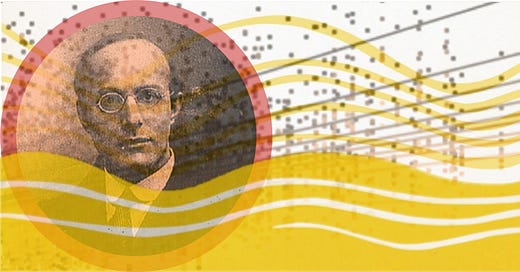Hello Interactors,
Where, how, and when people work continues to shift. Meanwhile, scores of people are moving to urban regions in search of opportunities. Some of which are more accessible than others. It’s putting stresses on how cities plan, how we move, and what kinds of freedoms are afforded and to whom. But hidden in the complexities of societies are patterns of hope.
As interactors, you’re special individuals self-selected to be a part of an evolutionary journey. You’re also members of an attentive community so I welcome your participation.
Please leave your comments below or email me directly.
Now let’s go…
REMOTE CONTROL
The workplace will never be the same again. What it becomes won’t either. But don’t tell Elon Musk. He threw a temper tantrum last week accusing employees at Tesla of slacking off working from home. In a company-wide email he became the over-controlling parent and grounded everyone. He wrote, “Everyone at Tesla is required to spend a minimum of 40 hours in the office per week” and that they “must be where your actual colleagues are located, not some remote pseudo office.” He claimed had he not been on the factory floor “working alongside” his employees that Tesla would have “long ago gone bankrupt.” I’m sure every factory floor worker he has replaced by a robot might have something to say about that.
Some work does require a physical presence. Teeth cleaning comes to mind. But there is something to coming together physically that is hard to replicate online. There are also many kinds of service jobs that require a physical presence, though some of those are getting replaced by robots. Last year, a Dallas restaurant turned to a Robot called Bella when they had trouble filling waiter jobs. The owner said, “They don’t complain and they’re happy to do it!” It even happily sings Happy Birthday.
But even white-collar jobs require some together time. I heard one academic say he worked two years during COVID on a joint research project over Zoom. When the team finally came together physically, they accomplished more in a single day than they did in those two years.
Every company from Tesla to Target are feeling the reverberations of pandemic induced workplace alterations. Even Microsoft, a company that has long envisioned the promise of hybrid-work, is struggling through a new rhythm and workplace model. Mandatory in-office strategies like Musk tried aren’t practical. Even senior leaders are choosing to move to remote locations. Meanwhile, some high-tech teams were already distributed around the world. Despite these trends, companies continue to build new office space. Cranes loom on the horizon all around Seattle. While some of these high-rises will be housing, much of it is office space. What will they do with all this space?
I met a new friend last week who is trying to figure that out. She works as a product designer for a company headquartered in Rotterdam called MapIQ. They build software and services that allow companies to optimize the space they have. She’s been busy conducting research. She talks to employees, facility managers, IT departments, human resources, and corporate realtors who are struggling with a new workplace reality. She told me one of the most acute issues for facility managers is space utilization. These companies pay a lot of money to have attractive and effective workplaces. Seeing them empty is troubling financially but also psychologically. She said, “Employees are struggling to know when it is best to come to the office. They don't want to be the only one at home in a hybrid meeting and they don't want to be in an empty office either.”
Facility managers are scrambling to find ways to make the most of what they have. She said one popular outcome is subletting workspace. But even subletters will only use it occasionally and sporadically. They use software and sensors to better manage who is using it, when, and for how long. This was not how these buildings were designed and not how these companies were envisioned to be run. MapIQ has identified five trends emerging in the workplace:
The office as standard. Most all employees work four or five days a week in the office.
Local hybrid. Most people work two or three days a week in the office.
Remote friendly. Most employees are in the office only once or twice a week.
Remote first. Working in the office is completely optional with no geographic requirement.
Fully distributed. There is no office at all and everyone works wherever they want.1
The nature of work in the foreseeable future is decidedly different than the past. It will take some time for optimizations to emerge. Meanwhile, how will this affect our built environment and how cities plan? Our roads, rails, wires, and spires, boulevards, buildings, drains and ditches were all planned and produced with a certain permanency and predictability that surrounds our economies, societies, and psychologies. These features of the physical and social landscape were assumed to be towering rocks anchored and resolute. But it turns out it was a mirage. They are made of sand and the winds of the pandemic has created a sandstorm. What shape these forms of fortune take is unknown and possibly unknowable.
The landscape of living amidst this storm is hard to predict and control. The best way to know what direction we’re headed is to look where we came from. Only then can we understand how we got here. A lot has changed in how and where we live. Since the end of WWII, the world’s population has more than tripled. Over half alive right now live in urban areas and nearly three-quarters will by 2050. North America is one of the most urbanized regions in the world. In 2018 82% of the population lived in urban areas. And it’s growing every day. Europe is 74% urbanized and their cities are also growing. Half of the world’s population lives in Asia and half of those live in urban areas.23
Not all regions grow at the same rate. The fastest growing areas are projected to continue to be in low-income and middle-income nations. Thirty-three of the fastest growing countries between 2000 and 2020 were in Africa. Twelve were in Asia. But urbanization is both a blessing and a curse. Access to better public health, nutrition, and education improves the lives of those who suffer most, but puts increased strains on housing, transportation, energy, and other infrastructure systems. This is having widespread, varying, and compounding impacts on all who live in urban areas. But these growing pains are not equally felt by all. Understanding these sensitivities will be necessary if we’re going to find ways to solve them.
SUPER SIZING THE SUPER RICH WITH SUPERLINEAR WEALTH
Urban scientists have found naturally occurring mathematical patterns in growing cities. They mimic power-laws found across a diverse array of cities just as they do across plants and animals. For example, as cities grow in population their GDP, number of patents, and productivity grow at a predictable scale. However, congestion, crime, and contagious diseases also predictably grow. Doubling the size of a city will increase wages, wealth, and innovation (as measured by number of patents) by roughly 15 percent. But so will garbage and theft. Population growth has a predictable superlinear positive and negative effect on urban areas.4 It’s the great paradox of urbanity.
There are big advantages to scale. With each doubling of population there’s also a 15 percent savings in total length of rail lines, electrical lines, water lines, and roads. This sublinear effect predictably leads to a city of 10 million people needing 15 percent less infrastructure than a city half its size. It pays to grow.
But these numbers, as predictable as they are, can also be misleading. Whenever population datasets get crunched and averaged the analysis ends up crunching the realities of the average person. Hidden in the convenient clustering of ‘low-income‘, ‘middle-income’, and ‘high-income’ are varying degrees, durations, and directions as diverse as those lived experiences of the people behind the numbers. This realization has led some of those same urban scaling researchers to scrutinize their own findings. Increased wealth disparities, for example, got them wondering. If wage growth is so predictable compared to urban growth, and more people are predictably moving to urban areas, why aren’t all wages predictably growing?
They wondered if there are similar scaling laws that predict income inequality based on city size. How are incomes different among the rich and the poor compared to the size of the city? After adjusting for cost-of-living differences, are poor people in a big city better off than poor people in a small city? Are rich people richer the bigger the city?
To answer their questions, they broke down income brackets into percentiles. Traditional economic inequality research looks at dispersed distributions across income or wealth. Meaningful individual differences are hidden in these distributions. What they found is the wealth of the poorest 10% scales almost linearly with population size. In contrast, the top 10% shows superlinear growth.5 This means poor folks moving closer to the city in hopes of becoming wealthier may find themselves to be continually poor compared to those in higher income brackets. The rich get richer, and the poor stay poor.
They conclude that “much has been written about the apparent increasing gains of large cities, such as greater GDP, higher wages, and more patents per capita.” But in the end, “the increasing benefits of city size are not evenly distributed to people within those cities.” For example, they found the ratio of housing costs to income is a function of city population size. The poorer the income brackets, the greater the proportion of income is spent on housing. This results in sharp increases in costs with city size. Meanwhile, in the wealthiest brackets the proportion of income spent on housing stays level.

So whatever superlinear growth in GDP, innovation, and wage growth that comes with increased city size is highly concentrated in the upper income brackets. Existing research in urban scaling and innovation points to empirical evidence that these gains are due in large part to the increase in social interactions and sharing of ideas. Larger and more diverse pools of people co-located in urban areas results in an explosion of creativity, opportunity, and resources. The accumulation of shared knowledge and passion only increases the potential for innovation.
This theory is found in the work of economist Karl Polanyi. In his landmark 1944 book, The Great Transformation, Polanyi gives this concept a name: embeddedness – those who share a common social context have an embedded relationship that drives a desire to provide for one another. Stanford economic sociologist, Mark Granovetter, reaffirmed the idea in his oft referenced 1973 paper, “The Strength of Weak Ties.”
And one of the most influential economists in the 20th century, Austrian turned American, Joseph Shumpeter, described these acts of economic invention and innovation as ‘creative destruction’. For every new innovation that brings increased wealth another must be destroyed or devalued. Capitalists celebrate it as the unfortunate inevitability of social and economic progress while Socialists deride it as the inevitable annihilating force of capitalism.
Karl Marx and Friedrich Engels wrote in their 1848 Communist Manifesto that,
“Modern bourgeois society, with its relations of production, of exchange and of property, a society that has conjured up such gigantic means of production and of exchange, is like the sorcerer who is no longer able to control the powers of the nether world whom he has called up by his spells… In these crises, there breaks out an epidemic that, in all earlier epochs, would have seemed an absurdity – the epidemic of over-production. Society suddenly finds itself put back into a state of momentary barbarism; it appears as if a famine, a universal war of devastation, had cut off the supply of every means of subsistence; industry and commerce seem to be destroyed; and why? Because there is too much civilisation, too much means of subsistence, too much industry, too much commerce.”
This grim prognosis from one of Capitalisms only inciteful critics is, sadly, all too relatable these days. Marx would not at all be surprised to hear there’s now empirical evidence to back his 174-year-old theory. But he would probably also be shocked to see China rising as a global superpower by combining elements of Capitalism with Socialism. Markets seem to have a way of formalizing Polanyi’s notion of embeddedness. He believed we all have the desire and creative ability to contribute to each others success and well being as part of our livelihoods. It’s not just goods and services that need exchanged but also values, moral concerns, and relationships. But to do that we must remain connected.
CONNECTING THE DOTS TO FREEDOM
Those urban scaling researchers hypothesize that one of the reasons income inequalities are so pronounce and unfairly propagated in our wealthiest cities is because the various income brackets have become increasingly geographically and socially segregated. Like ecosystems, the less diversity there is the greater the propensity to collapse. These researchers warn that urban regions that “inhibit mixing between diverse populations, will underperform with respect to income scaling.” If lessening income inequality is a goal, the research suggests “cities that are better mixed, allowing diverse parts of the population to be exposed to one another, should be overperforming with respect to urban scaling.”
Connecting diverse sets of people across urban regions seems a more productive, and fun, way to tackle income inequality than redistribution of wealth through a government program. Ricardo Hausmann is the founder and Director of Harvard University’s Growth Lab. They uncover international growth diagnostics and develop economic complexity research methodologies. In a recent interview he said,
“In my mind, the real solution to inequality is not so much redistribution as inclusion – as incorporating people into the possibility of mixing what they are…that leads to a very different agenda for inequality reduction. Do you send people a check or do you connect them to the urban transport network?...Do you connect it to the labor market? Do you connect to the schooling system?”
He was joined in this interview by J. Doyne Farmer. He is the Director of Complexity Economics at the Oxford Institute of New Economic Thinking. Farmer points out that when economists look at the distribution of productivity, they commonly use a statistical technique that lops off a chunk of a giant tail of the distribution curve that is seemingly inconsequential to their analysis. This gives them a distorted point of view of productivity. And to underline Hausmann’s point about the importance of diversity needed to be connected, he said, “that there's a huge diversity out there” hidden in the fat tails those distribution curves. He adds, “And we really have to cope with that because it's inherent to the economy.”
The question is, how connected physically do people have to be, how often, and for how long to achieve optimal productivity gains? These are questions being asked by companies around the world and firms like MapIQ are there to help answer them. But how many of these companies are already segregating themselves from the socio-economic diversity of their headquarters, satellite offices, or shared urban and suburban workspaces?
Arjun Ramani, a Stanford economist and journalist for The Economist, said last year in an interview by Leesman, a leader in workplace research, that “people are now willing to live an hour away in exchange for a bigger house, because they don’t have to commute in every day.” He believes it’s leading to the ‘donuting’ of cities which I mentioned may be occurring in Des Moines, Iowa. Ramani also reminds us that in the 1800s 40% of workers were working from home. He said, “working from home was quite common. Workers would go into a city or to a market to get raw materials and goods and return home to work – for example in the manufacture of clothes.”
Today that just may be a 3D printer in a suburban garage or a rural toolshed, but the materials would probably be delivered to their door or flown in on a drone. But there’s no question some segment of jobs will require a more centralized physical presence. I’m not yet ready to have my teeth cleaned by a robot, though it looks like that also may be around the corner too. Even farming is moving toward robots.
Regardless of what kind of job is available or desired or how much physical presence needed, there is little question getting more people connected – regardless of where they live – increases the odds of diverse interactions. My own experience tells me, and mounds of research supports, diverse collections of people and ideas yield unexpectedly miraculous outcomes. It’s not always easy or pleasant working with people of differing backgrounds, beliefs, and inclinations, but out of contention come good ideas.
It's also hard to imagine how we become more connected amidst increasing geographic segregation, political polarization, religious ideology, and economic disparities. This may be today’s most perplexing social dilemma. It seems each opportunity to come together is met with an excuse to move apart. Meanwhile, there are powerful forces alive today bent on suppressing individual freedoms. And yet we live in a time when personal freedoms to choose where to live and where work are reignited. But those freedoms are not afforded to all which is an unjust outcome of an unjust history. And so the struggle continues.
It’s sometimes hard to remain optimistic as the sand dunes of our institutions are shaped by the unpredictable storms of change. But hidden in the complexities of distribution curves, growing populations, and the shifting sands of urbanity are predictable patterns that offer us clues – kernels of clarity and certainty; pathways to pursue, and lessons to learn. It’s the certainty we need if we want to uphold our freedoms.
When Polanyi wrote about the great transformation occurring in 1944 it was during a dark time. He started the book during the depression in the 1930s and had lived through political and economic upheaval in England. A world war preceded his writing, and the book was published during a second. He recognized the complexity of society and spoke of the freedoms that come with it.
In the final chapter titled, Freedom in a Complex Society, he writes,
“Uncomplaining acceptance of the reality of society gives man indomitable courage and strength to remove all removable injustice and unfreedom. As long as he is true to his task of creating more abundant freedom for all, he need not fear that either power or planning will turn against him and destroy the freedom he is building by their instrumentality. This is the meaning of freedom in a complex society; it gives us all the certainty that we need.”6
Global Population Growth and Sustainable Development. United Nations. 2021.
Scale: The Universal Laws of Growth, Innovation, Sustainability, and the Pace of Life in Organisms, Cities, Economies, and Companies. Geoffrey West. 2017.
Scaling of urban income inequality in the United States. Elisa Heinrich Mora, Cate Heine, Jacob J. Jackson, Geoffrey B. West, Vicky Chuqiao Yang, and Christopher P. Kempes. 2021
The Great Transformation. The Political and Economic Origins of Our Time. Karl Polanyi. 1944.
















Share this post